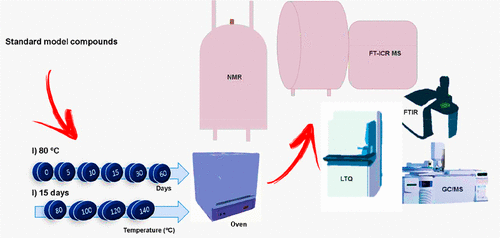当前位置:
X-MOL 学术
›
Energy Fuels
›
论文详情
Our official English website, www.x-mol.net, welcomes your
feedback! (Note: you will need to create a separate account there.)
Study of Thermal Aging of Model Compounds Present in Asphalt Cement by GC/MS, ESI-MS, NMR, and FTIR
Energy & Fuels ( IF 5.2 ) Pub Date : 2021-08-26 , DOI: 10.1021/acs.energyfuels.1c01815 Natã C. L. Madeira 1 , Polianna da S. Ferreira 1 , João F. Allochio Filho 1 , Luiz S. Chinelatto 2 , Margareth C. C. Cravo 2 , Adriana T. Martins 2 , Valdemar Lacerda 1 , Wanderson Romão 1, 3
Energy & Fuels ( IF 5.2 ) Pub Date : 2021-08-26 , DOI: 10.1021/acs.energyfuels.1c01815 Natã C. L. Madeira 1 , Polianna da S. Ferreira 1 , João F. Allochio Filho 1 , Luiz S. Chinelatto 2 , Margareth C. C. Cravo 2 , Adriana T. Martins 2 , Valdemar Lacerda 1 , Wanderson Romão 1, 3
Affiliation

|
The study of petroleum asphalt cement (AC) aging is essential for the production of good quality pavements with high durability. Because of the complexity of this material, one of the biggest challenges is understanding the chemical variations that occur in the molecules present in the AC during the aging processes. This work proposes to study 15 standards of model compounds present in the AC composition, representing the fractions of saturated compounds (5-α-cholestane and hexatriacontane), aromatics (hexamethylbenzene, coronene, and benzo[a]anthracene), nitrogenous compounds (acridine, carbazole, indole, and N,N′-Bis(3-pentyl)perylene-3,4,9,10-bis(dicarboximide)), sulfur compounds (2-naphthalenethiol, 4,6-diethyldibenzothiophene, and naphtho[1,2-b:6,5-b′]dithiophene(NDT)), and naphthenic acids (stearic (SA), pentadecanoic (PA), and sinapinic acids (ASN)), which were thermally aged by two methods: (i) they were subjected to a constant temperature of 80 °C, varying the time of analysis over 5, 10, 15, 30, and 60 days; and (ii) temperatures ranging from 80, 100, 120, to 140 °C for 15 days. The analyses of these compounds were performed by GC/MS, 1H and 13C NMR, ESI(−)MS (FT-ICR and LTQ), and FTIR. The results obtained showed that at 80 °C, from 15 days, only the indole standard compound showed the presence of thermal products, i.e., compounds detected from thermal aging of the standard model compounds. When the degradation temperature was increased from 100 to 140 °C, we observed the formation of thermal products at 100 °C in 6 out of 15 model compounds. However, at 140 °C, 12 of the 15 model compounds presented some type of degradation. Reactions of oxidation, polymerization, thermal aging, volatilization, and formation of double bonds were observed.
中文翻译:

通过 GC/MS、ESI-MS、NMR 和 FTIR 研究沥青水泥中存在的模型化合物的热老化
石油沥青水泥 (AC) 老化研究对于生产具有高耐久性的优质路面至关重要。由于这种材料的复杂性,最大的挑战之一是了解老化过程中存在于 AC 中的分子中发生的化学变化。这项工作建议研究 AC 组合物中存在的模型化合物的 15 种标准,代表饱和化合物(5-α-胆甾烷和六十三烷)、芳烃(六甲苯、晕苯和苯并[a]蒽)、含氮化合物(吖啶)的分数、咔唑、吲哚和 N,N'-双(3-戊基)苝-3,4,9,10-双(二甲酰亚胺))、硫化合物(2-萘硫醇、4,6-二乙基二苯并噻吩和萘并[1] ,2-b:6,5-b']二噻吩 (NDT)) 和环烷酸(硬脂酸 (SA)、十五烷酸 (PA)、和芥子酸 (ASN)),它们通过两种方法进行热老化:(i) 将它们置于 80 °C 的恒温下,在 5、10、15、30 和 60 天内改变分析时间;(ii) 温度范围为 80、100、120 至 140°C,持续 15 天。这些化合物的分析通过 GC/MS 进行,1 H 和13 C NMR、ESI(-)MS(FT-ICR 和 LTQ)和 FTIR。获得的结果表明,在 80 °C 下,从 15 天开始,只有吲哚标准化合物显示存在热产物,即从标准模型化合物的热老化中检测到的化合物。当降解温度从 100 °C 增加到 140 °C 时,我们观察到 15 种模型化合物中有 6 种在 100 °C 下形成了热产物。然而,在 140 °C 时,15 种模型化合物中有 12 种出现了某种降解。观察到氧化、聚合、热老化、挥发和形成双键的反应。
更新日期:2021-09-16
中文翻译:

通过 GC/MS、ESI-MS、NMR 和 FTIR 研究沥青水泥中存在的模型化合物的热老化
石油沥青水泥 (AC) 老化研究对于生产具有高耐久性的优质路面至关重要。由于这种材料的复杂性,最大的挑战之一是了解老化过程中存在于 AC 中的分子中发生的化学变化。这项工作建议研究 AC 组合物中存在的模型化合物的 15 种标准,代表饱和化合物(5-α-胆甾烷和六十三烷)、芳烃(六甲苯、晕苯和苯并[a]蒽)、含氮化合物(吖啶)的分数、咔唑、吲哚和 N,N'-双(3-戊基)苝-3,4,9,10-双(二甲酰亚胺))、硫化合物(2-萘硫醇、4,6-二乙基二苯并噻吩和萘并[1] ,2-b:6,5-b']二噻吩 (NDT)) 和环烷酸(硬脂酸 (SA)、十五烷酸 (PA)、和芥子酸 (ASN)),它们通过两种方法进行热老化:(i) 将它们置于 80 °C 的恒温下,在 5、10、15、30 和 60 天内改变分析时间;(ii) 温度范围为 80、100、120 至 140°C,持续 15 天。这些化合物的分析通过 GC/MS 进行,1 H 和13 C NMR、ESI(-)MS(FT-ICR 和 LTQ)和 FTIR。获得的结果表明,在 80 °C 下,从 15 天开始,只有吲哚标准化合物显示存在热产物,即从标准模型化合物的热老化中检测到的化合物。当降解温度从 100 °C 增加到 140 °C 时,我们观察到 15 种模型化合物中有 6 种在 100 °C 下形成了热产物。然而,在 140 °C 时,15 种模型化合物中有 12 种出现了某种降解。观察到氧化、聚合、热老化、挥发和形成双键的反应。











































 京公网安备 11010802027423号
京公网安备 11010802027423号